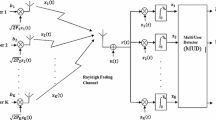Abstract
The usage of productive baseband receivers are portrayed by reasonable computational load is an urgent point in the advancement of transmission frameworks misusing assorted qualities in various spaces.Several research works have been published in the literature ofspace-time block codes multi-carrier code-division multiple-access (STBC MC-CDMA)Systems based on minimum conditional bit error rate Criterion. As like, in our previous paper, an efficient STBC communication system was performed using oppositional krill herd algorithm (OKHA). To overcome the drawbacks in the previous work, in this work we proposed a hybrid Particle swarm optimization (PSO) and group search optimization (GSO), called PSGSO based Multi-User Detection in STBC MC-CDMA Systems. In this paper, we use the Alamouti’s STBC encoder for transmitting sequence and the channel estimation matrix is optimally evaluated using PSGSO algorithm. The simulation results show that the proposed algorithm is properly reducing the bit error rate (BER), symbol error rate (SER) and properly increase the spectral efficiency value compare to other techniques.



















Similar content being viewed by others
References
Alamouti SM (1998) A simple transmit diversity technique for wireless communications. IEEE J Selec Areas Comm 16(8):1451–1458
Amok JOM, Saad NM (2015) Error rate performance analysis of multiantenna MC DS-CDMA system over – frequency selective fading channels with arbitrary parameters. Int J Electron Commun (AEÜ)
Arifianto MS, Chekimaand A, Barukang, L (2007) Binary Genetic Algorithm Assisted Multiuser Detector for STBC MC-CDMA. IEEE, 1–5.
Bader F, Zazo S, Raos I (2002) Improvement on the multi-user detection decorrelator of a MC-CDMA used in the reverse link. IEEE Trans Personal Indoor Mobile Radio 1:409–413
Baro S, Bauch G, Pavlic A, Semmler A (2000) Improving BLAST performance using space-time block codes and turbo decoding. In: proceedings of IEEE Globecom. 2: 1067-1071.
Benyarou M, Bendimerad FT, Debbat F (2013) Multi-user-detection for multibeam-MIMOMulti-carrier-Cdma systems with MMSE adaptive algorithm. IJCSI Intl J Comput Sci Issues 10(3):195
Caldwell R, Anpalagan A (2005) Meeting mobile’s demands with multicarrier systems. IEEE Potentials 24(5):27–31
Couzin ID, Krause J, Franks NR, Levin SA (2005) Effective leadership and decision-making in animal groups on the move. Nature. 434:513–516
D’Orazio L, Sacchi, C, Fedrizzi R (2007) An adaptive minimum-BER approach for MultiUser detection in STBC-MIMO MC-CDMA systems. IEEE. 3427-3431.
Gesbert D, Shafi M, Shiu DS, Smith PJ, Naguib A (2003) From theory to practice: an overview of MIMO space-time coded wireless system. IEEE J Sel Areas in Comm 21(3):281–301
Hara S, Prasad R (1999) Design and performance of multicarrier CDMA system in frequency-selective Rayleigh fading channels. IEEE Trans Veh Technol 48:1584–1595
Hassibi B, Hochwald B (2002) High rate codes that are linear in space and time. IEEE Trans Inform Theory 48:1804–1824
He S, Wu QH, Saunders JR (2006) A group search optimizer for neural network training. Lect Notes Comput Sci:934–943
Ma WK, Davidson TN, Wong KM, Luo ZQ, Ching PC (2002) Quasi-maximum-likelihood multiuser detection using semi-definite relaxation with application to synchronous CDMA. IEEE Trans Signal Processing 50(4):912–922
Miller SL, Rainbolt BJ (2000) MMSE Detection of Multicarrier CDMA. IEEE J Select Areas Commun 18(11):2356–2362
Nagaradjane P, Krishnan L, Vasan ASS (2012) Performance analysis of multicell multiuser MIMO MC DS/CDMA system with MMSE user-ordered SIC technique. Comput Electr Eng 38:105–115
Namgoong J, Wong TF, Lehnert JS (2000) Subspace multiuser detection for multicarrier DS-CDMA. IEEE Trans Commun 48(11):1897–1908
Paulraj AJ, Papadias CB (1997) Space-time processing for wireless communications. IEEE SigProcess Mag 14:49–83
Rong Y, Shahbazpanahi S, Gershman AB (2005) Robust linear receivers for space–time block coded multi-access MIMO systems with imperfect channel state information. IEEE Trans Signal Process 53(8):3081–3090
Sethuraman BA, Rajan BS, Shashidhar V (2003) Full-diversity, highrate space-time block codes from division algebras. IEEE Trans Inform Theory 49(10):2596–2616
Sun W, Li H, Amin M (2003) MMSE detection for space-time coded MC-CDMA. IEEE international conference on communications. Cape Town 5(11–15):3452–3456
Vardhan V, Mohammed SK, Chockalingam A (2008) A low-complexity detector for large MIMO systems and multicarrier CDMA systems. IEEE J Selected Areas Commun 26(3):473–485
Wolniansky PW, Foschini GJ, Golden GD, Valenzuela RA (1998) V-BLAST: an architecture for realizing very high data rates over the rich-scattering wireless channel. Intl symposium signals syst electron 29(2):295–300
Wong KK, Murch RD, Letaief KB (2002) Performance enhancement of multiuser MIMO wireless communication systems. IEEE Trans Commun 50(20):1960–1968
Yang J, Sun Y, Senior J, Pem, N. (2003) Channel Estimation for Wireless Communications using Space-Time Block Coding Techniques. Proc. of 2003 IEEE Int. Symp. on Circuits and Systems. 2: 220–223.
Yang LL, Hua W, Hanzo L (2006) Multiuser detection assisted time- and frequency-domain spread multicarrier code division multiple-access. IEEE Trans Veh Technol 55(1):397–405
Yu JL, Lee MF, Lin CC (2009) Multiuser receivers for MC-CDMA MIMO systems with space–time block codes. Signal Process 89:99–110
Yuen C, Guan L, Tjhung TT (2005) Quasi-orthogonal STBC with minimum decoding complexity. IEEE Trans Wireless Comm 4(5):2089–2094
Author information
Authors and Affiliations
Corresponding author
Additional information
Publisher’s note
Springer Nature remains neutral with regard to jurisdictional claims in published maps and institutional affiliations.
Rights and permissions
About this article
Cite this article
Sreesudha, P., Malleswari, B.L. A hybridization approach of PSO and GSO algorithm for minimum-BER based multi-user detection in STBC-MIMO MC-CDMA systems. Multimed Tools Appl 80, 31967–31992 (2021). https://doi.org/10.1007/s11042-021-11091-9
Received:
Revised:
Accepted:
Published:
Issue Date:
DOI: https://doi.org/10.1007/s11042-021-11091-9




